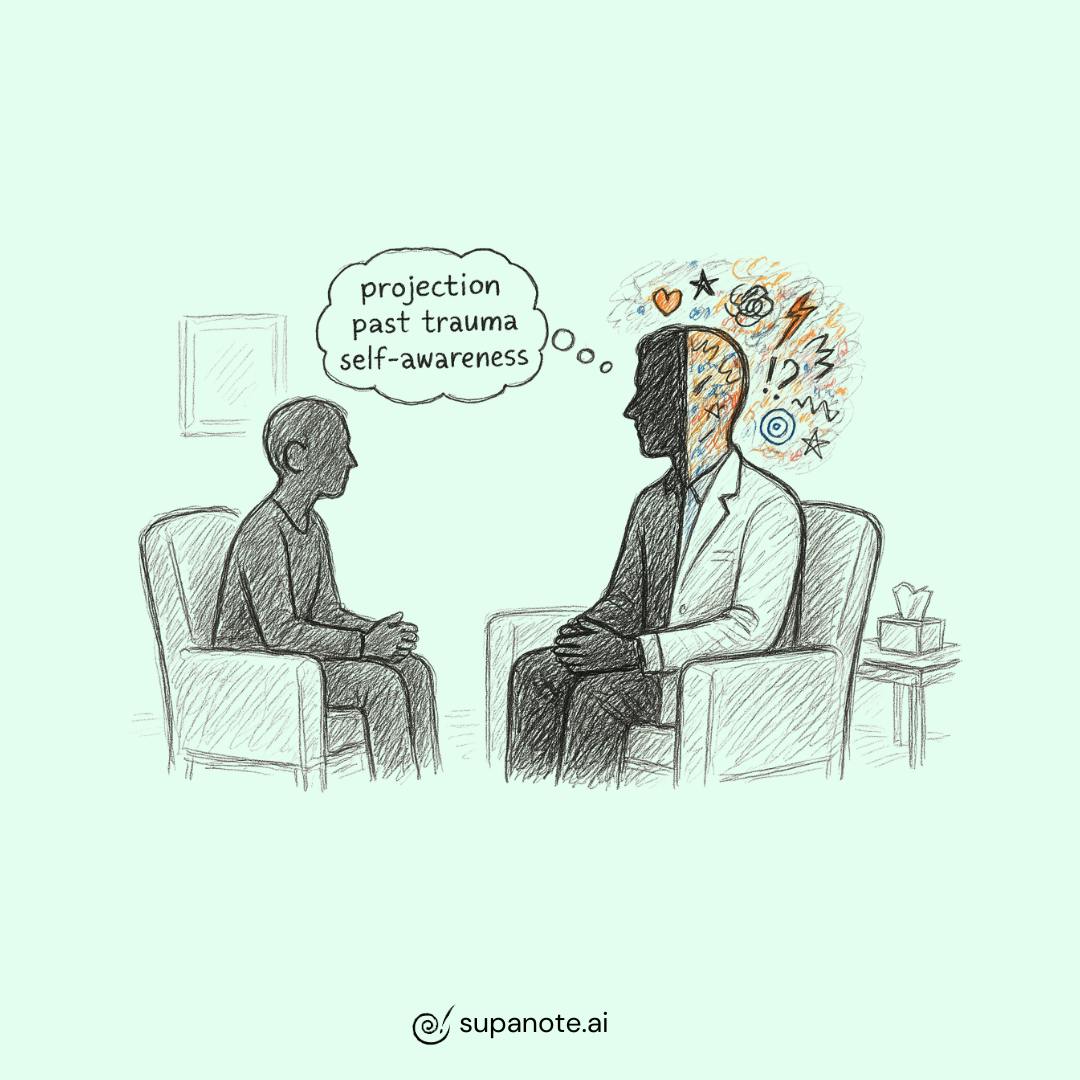It starts subtly.
You're in the middle of a session with a particular client, and suddenly, a wave of irritation hits you. They’re describing their situation, but your emotional response feels out of proportion. Maybe it’s a tightness in your chest. Or a strong urge to change the topic.
This, therapists, might be your first clue that you're experiencing countertransference.
In the world of modern psychotherapy, countertransference in therapy isn’t just theory.
It's part of the therapeutic relationship always present, especially in adult therapy and child therapy.
So, whether you're a new therapist or one of the seasoned clinicians, it matters. Your own feelings, personal experiences, and therapist's personal issues shape the work. They influence the dynamic between the therapist and the client.
Therefore, understanding countertransference helps both the therapist and client stay aligned—and move towards healing.
What Is Countertransference? (And What It’s Not)
Countertransference happens when the therapist's feelings, shaped by their personal experiences, unresolved trauma, or unconscious patterns, get projected onto the therapist's client.
Originally coined by Sigmund Freud, the term described how a therapist’s reaction to a client’s transference could block effective therapy.
But that view has evolved.
Today, contemporary psychiatric treatment sees countertransference differently, not as a therapist's flaw, but as a source of valuable insights, if it's noticed and addressed.

Case Example:
A client talks about their emotionally distant parent. The therapist acts unusually cold or overly critical. This may signal a subjective countertransference reaction linked to their own therapy or family history.
The key here is self-awareness.
The therapist is experiencing countertransference when their own emotions blur the objectivity needed for effective psychotherapy.
You might feel unusually irritated, protective, anxious or even an excessive positive feeling toward a particular client.
These countertransference reactions are your cue to pause and reflect.
Transference vs Countertransference: What’s the Difference?
- Transference is when a client projects feelings from past relationships onto the therapist.
- Countertransference is when the therapist projects their own feelings onto the client based on the therapist's internal world, not the client's experiences.
For instance, a client's transference might involve idealizing the therapist as a parental figure.
If the therapist's reaction is to feel unusually flattered or responsible, it's then when countertransference occurs.
Lets look at an example to help this understand better:
A client who had a distant and emotionally unavailable father begins to see the therapist as a protective, nurturing figure. They start depending heavily on the therapist's approval, seeking reassurance frequently. This is transference - the client is unconsciously replaying unmet childhood needs.
In response, the therapist starts feeling deeply responsible for the client’s emotional well-being, extending sessions or offering advice outside the clinical frame. They notice feeling guilty when setting limits. This is countertransference - the therapist's own unresolved issues around worth or caretaking are shaping their professional behavior.
Understanding both dynamics allows the therapist to return to a grounded, reflective stance and explore the therapeutic relationship more meaningfully.
Some Real-Life Examples of Countertransference
- A therapist begins overidentifying with a client who reminds them of their sibling. This leads to overly sympathetic interventions, blurring professional boundaries.
- Another finds themselves being overly critical of a client who challenges authority—because they resemble a controlling parent.
In both cases, recognize countertransference early = prevent derailment of the treatment process.
Signs of Countertransference in the Therapy Room
Recognizing these emotional reactions early can make the difference between insight and clinical blind spots. Here are some warning signs:
- You have an unreasonable dislike or overly intense emotional pull toward a client.
- You feel the need to rescue or fix your client beyond the scope of your therapist's job.
- You experience strong urges to self-disclose irrelevant personal stories.
- You dread or look forward to a therapy session with a specific client for non-clinical reasons.
In systematic review literature and meta analytic findings, these reactions are seen as both risks and opportunities, depending on how they’re managed.
Types of Countertransference
- Positive countertransference: When a therapist feels warm, idealizing, or overly connected. Think: feeling like a client is your favorite or wanting to be their savior.
- Negative countertransference: When uncomfortable feelings like irritation, avoidance, or disgust arise, leading to distancing behaviors or judgment.
- Objective countertransference: Reactions that are reasonable responses to the client’s actual behavior.
- Subjective countertransference: Reactions triggered by the therapist's personal issues, unrelated to the client’s reality.
What Causes Countertransference to Start at the very first place?
It often begins quietly - when the therapist's work touches on their unresolved conflicts or trauma.
A client's experiences may echo your own childhood dynamics, cultural values, or relationship patterns. When your internal world bleeds into the treatment process, that's when things get messy.
In projective identification, for example, the client projects intense emotions which the therapist begins to feel and unconsciously act on.
This is where self-awareness is non-negotiable.
Can Countertransference Ever Be a Good Thing?
Yes, view countertransference as a mirror. When properly managed, it can:
- Deepen empathy and therapeutic attunement.
- Reveal what the patient’s internal world might feel like to others.
- Serve as a tool to reflect on professional boundaries and treatment direction.
Beneficial outcomes arise when countertransference management is rooted in curiosity and humility.
How to Manage Countertransference Practically
- Name it: The moment you feel an inappropriate emotional response, flag it. Make note of your shift in mood, tone, or presence.
- Don’t react, reflect: Not all instincts are therapeutic. If your direct response feels personal, pause.
- Use supervision wisely: Clinical supervision is your lab. Share your feelings. Ask: What’s mine? What’s theirs?
- Lean on personal psychotherapy: Your own therapy is where the deepest countertransference work happens. It helps you work through your unresolved issues.
- Document neutrally: Even in charged sessions, avoid emotional language. Supanote can help maintain clarity.
- Re-establish boundaries: If professional boundaries get shaky, reinforce them quickly and clearly.
Remember, the goal isn’t to eliminate countertransference altogether. It’s to manage it mindfully, as part of your therapist’s work.
Don’t Let Countertransference Cloud Your Notes
When sessions get emotionally intense, it’s not just your clients processing something - it’s you, too. Supanote gets that.
With one of our newest features- Supa AI, you don’t even have to muscle through messy drafts or second-guess your wording. Just hit 'Tell Supa' and describe what you want - a clearer tone, cleaner structure, or help capturing the clinical significance of a charged moment.
It’s especially useful when you're working through countertransference.
Instead of letting your emotions spill into your notes or get buried under vague language, Supanote helps you document with clarity and self-awareness.
Because reflecting on your own reactions shouldn’t come at the cost of good documentation - and with Supanote, it doesn’t have to.
Ready to try? 10 notes on us!
Login to your Supanote account and instantly access 10 free notes
Try Supanote for Free Now!
FAQs Therapists Ask (and Deserve Honest Answers)
Q: What is an example of countertransference?
A: A therapist feeling intense protectiveness over a client who reminds them of a child or sibling leading to biased decision-making.
Q: What is the difference between transference and countertransference?
A: Transference = client’s feelings toward therapist. Countertransference = therapist's reaction based on their own personal feelings.
Q: How do you recognize countertransference?
A: Emotional surges, dread or excitement about sessions, impulsive urges to over-help or judge those are all signs of countertransference.
Q: Is countertransference a good thing?
A: Yes, if recognized. It can lead to positive outcomes, empathy, and alignment with the client’s internal world.
Q: Can countertransference be unconscious?
A: Yes, most of it starts beneath the surface. You often notice it only after your behavior or mood shifts.
Q: Should I tell my client if I notice countertransference?
A: Rarely. It’s best processed in supervision, not shared directly unless therapeutically necessary.
Q: How does countertransference show up in teletherapy?
A: Subtle shifts in tone, distraction, or frustration with a client’s setting are common signs.
Q: Can positive countertransference be harmful?
A: Yes. Idealizing clients or over-identifying can lead to blurred boundaries and biased care.
Q: How do I talk about countertransference in supervision?
A: Frame it as curiosity, not failure. It shows you're reflecting, not reacting.
Resources to Deepen Your Practice
- GoodTherapy Psychpedia
- Relational Psych on Countertransference
- On Being a Therapist by Jeffrey Kottler
- CEU: Transference & Countertransference Essentials
Conclusion
Countertransference isn’t a clinical sin - it’s a signal. A mirror. A tool.
Left unchecked, it can lead to inappropriate emotional responses and blurred boundaries.
But when harnessed? It unlocks beneficial outcomes, strengthens the therapeutic relationship, and brings depth to your therapist’s work.
You don’t have to handle it alone. Use your clinical supervision, your own therapy, and tools like Supanote to help you track, understand, and transform your countertransference reactions into something useful- for both you and your client.

